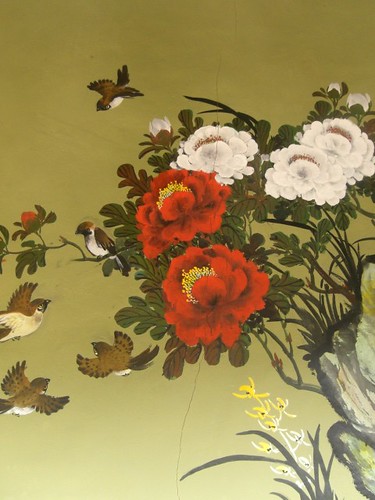Here's a little background from The Marmot's Hole:
Overall it was a pretty rotten trip, but I'll talk about that below. Here are some pictures, sans captions. For some reason, the spacing and text get screwed up whenever I preview, and what looks like one space here becomes three spaces in the published version. After about four tries, I've given up on explanatory captions, and instead refer you to my flickr page for more information. Here are photos of: Rainbow Bridge, Beolgyo Pogyodang, a Joro spider, an abandoned church, a view of Beolgyo from Buyongsan Park, the Financial Collective building, Beolgyo Station, another Japanese-style building, and Hoejeongni Church.If you’ve got an interest in contemporary Korean history, there’s plenty to see and feel in Beolgyo, a town that is, for all intents and purposes, a product of Japanese colonial policy. The town was developed as a transportation center to ship agricultural goods from the Jeolla provinces to ports like Yeosu. The Japanese also engaged in a number of ambitious but divisive land reclamation products in the area. The Japanese penetration of the region and the colonial projects they pursued intensified class and ideological conflicts in the Beolgyo area that long outlived colonial rule. Jo’s The Taebaek Mountains examines this colonial legacy and the tragic conflicts that ripped South Korean society in the years between Liberation and the end of the Korean War.
Beolgyo’s downtown area is a place only a Japanese colonial administrator could love. Which, in a way, makes it kind of interesting. Like Gunsan, there are a number of old colonial-era buildings maintained as reminders of Korea’s difficult past. The town does get a fair number of visitors who come looking for the different places described in Jo’s book. Many of them, including the old Japanese Financial Collective building, Kim Beom-woo’s home, the Japanese-style Boseong Inn (now called the Namdo Inn), and the Sohwa Bridge, where mass executions took place during the 1948 Yeosu-Suncheon Uprising and, in the novel, rightists and leftists apparently traded turns executing political opponents.











There are 40-some pictures on my flickr page, and further information about these sites, or about a Beolgyo self-guided walk-through can be found on the Galbijim page.
Anyway, the trip was pretty shitty. The tourist map I was able to find hanging in town said "you are here," but I was not "here." It took me a long time to realize that the map had been moved some 5 blocks away, a big difference in a small town. The map showed the location of 16 sites from Taebaek Sanmaek, though I was only able to find 7. The small mountain, 부용산 (Buyongsan) had maps along the trails, but they seemed more for decoration than for guidance, and basically pointed in contradictory ways. And, I had to put up with pretty aggressive and abusive behavior from some of the local students. Screams of "Fuck you," curses and taunts in Korean, the finger, and having a tennis ball thrown at me made me really happy to finally get back to the bus terminal.
Korean students tend to be disrespectful to foreigners as their default behavior. Unless they are taught to act otherwise, its fairly common to get shouted at, to get pelted with "하이이이이" (mispronounced "hi"), "hello," "hey," "you," "and other misused salutations. I teach my students how to greet me on the first day of school, and I don't tolerate "hi," "hey," "you," "come here," or "hello," nor do I respond to people shouting my name. I've been with plenty of foreigners who consider this behavior cute, or polite, or a demonstration of Koreans' curiosity, or interest in English, or interest in foreigners, and I've seen it explained in journals as a liberating experience, as English does not have the various speech levels Korean does (thus many Koreans incorrectly assume that politeness need not be minded in English). I ignore the "hi"s, and "hello"s, and "나이스투미츄"s on the street, and I always request that Korean speak to me in Korean. Sadly, I've been around foreigners who respond to every piece of shit who yells "hi" at them, and it sort of undermines what I'm doing. Anyway, I'm not sure exactly how the habit of shouting at foreigners came about, but it's one I try not to encourage.
Update: A write-up I did for the Gwangju News was published in the October, 2007 edition. Click here to visit their page, which links to a .pdf file of the October issue.

No comments:
Post a Comment